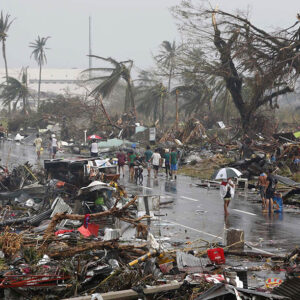Let’s talk business: Is yours prepared to handle an emergency?

This weekend marked one of the strongest – if not the strongest – storms ever to have taken place on earth: Super Typhoon Haiyan, with surges as high as trees and wind gust reaching 175 miles per hour ravaging the Phillipines. An estimated 10,000 are thought to have perished.
Rightfully so, the majority of attention has focused on families and individuals, but what has been the impact on businesses, both small and large? Cebu, a hard-hit province of 3.8 million people, is a center for outsourcing operations, with U.S. companies, including United Healthcare, having offices there. It’s also a major tourism and shipbuilding center. Many of those businesses were likely closed or had to serve as shelters for hundreds – if not thousands – of individuals displaced by the storm.
So, is your business prepared to handle such an emergency? What if your building needs to double as a shelter for your employees or even those of neighboring business? Would you be prepared to keep them fed and warm until other forms of emergency aid arrived?
My client, Phil Cox of Legacy Food Storage, recently contributed disaster preparation tips for small businesses to an article for SmallBusinessComputing.com. While these were focused on small businesses, they can also be applied to large businesses as well.
Here are the key points he gave to writer Pedro Hernandez :
Abide by the 3-Week Rule
Arrange “to have food, fuel and water for three weeks,” says Cox.
Don’t expect your region to bounce back quickly and for supplies to start flowing immediately in the aftermath of a disaster. Employees may be cut off from their own supplies if they happen to be at work when an emergency strikes your area.
Cox recommends storing enough food to provide your workers with 2,000 calories a day and two to three gallons of water each. In terms of fuel to heat food and to provide some warmth, look into long-lasting, shelf-stable diethylene glycol canisters.
Prepare 72-Hour Kits
Your office may be pulling double duty as a shelter for your employees. Cox suggests gathering “basic emergency supplies” into a 72-hour kit. These should include a first aid kit, flashlight, radio, a change of clothing and a poncho. These items will come in especially handy if your staffers need to venture out, or worse, if ordered to evacuate.
Get the Most Disaster Prep for Your Money
Though it may seem a little crass to put a price tag on survival, use your budgeting skills to ensure that both your workers and your finances emerge unscathed from a disaster.
“Small businesses, like mine, can more than take care of their employees with little spend,”says Cox. Look beyond the price tag and “understand what the money buys you.”
Consider the shelf life of survival products, the quality of food items and how many “good” calories they provide in your calculations. Don’t get hung up on serving sizes; focus on total calories. In an emergency, it’s unlikely that you’ll be doing much measuring or portion control.
Remember to factor in the storage of emergency rations and supplies. While it’s good to be prepared, don’t stockpile unnecessarily. Find a happy medium.
Keep the Lights On, Affordably
In terms of emergency generators, “go with the basics,” advises Cox.
Not all small businesses have the means to install expensive backup power systems, and that’s OK. During an emergency, your priority is survival, not business continuity.
Although a gas-powered generator from Amazon, Home Depot or Lowes isn’t likely to restore full power to your shop, it will be enough to keep cell phones charged and the essentials going. You can get back to business after your staff is safe and sound.
Is your business prepared? I’m motivated to make sure we are!
